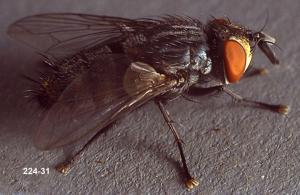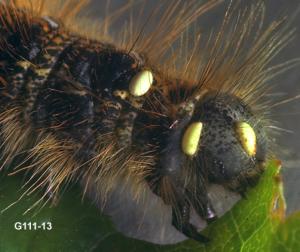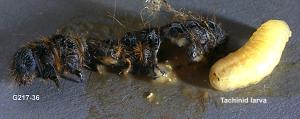Contents
Identification
Fact
Sheet (requires Acrobat Reader 3.x or
above to read and print. Click below to download the free "Reader".)

Registered
Insecticides
References
[Insect
Management]
[Home] |
|
 
|
 Parasite populations may lag behind those of the prey, which may result in
large numbers of pests being present before sufficient numbers of parasites are present to
control pest populations. Nevertheless, parasites are important regulating factors of
pests in mint. Parasitized insects may be conspicuous enough to be observed in the field -
usually swollen or immobile. If the parasite has matured, the host may be covered with
tiny cocoons or it may be hollow. It is important to look for parasitized insects when
fields are being routinely sampled for pest insects. If a large number of parasitized
insects are found, it may not be necessary to treat with an insecticide. |
| Tachinid Parasite Adults |
Tachinid Parasite Eggs |
 |
Adults are 6 to 14 mm long and bee-like
in appearance. Most are dark brown or black and marked with contrasting areas of tan, red,
yellow, gold, or orange. The body is covered with long bristly hairs. Larvae are
maggot-like, white, and may be marked with bands of spines, which encircle the body
segments. Most tachinids overwinter as pupae in the soil. Adults emerge in the spring and
deposit eggs or first-stage larvae in or on the prey. Adults emerge about 2 to 3 weeks
later and deposit eggs for a second generation. There are usually 2 to 3 overlapping
generations each year. |
Tachinid Parasite
Larvae on Prey |
View the Fact
Sheet for More Information |
This section contains information on the
identification of tachinid parasites. The Fact Sheet contains specific information on
identifcation and biology of these parasites (requires Acrobat Reader).
|




